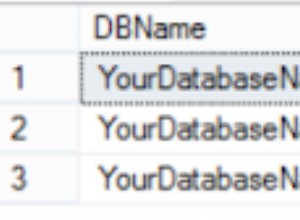Sei sicuro che la tua seconda domanda sia davvero OK?
1) Id =d.Id, <=Perché questa virgola (non molto importante)? ('ID =' è ridondante)
2) .Where(m => m.Trash ==false) <='Cestino' non è nella selezione, quindi questa proprietà non è nota in questo momento
3) .OrderByDescending(f => f.Created) <=idem for 'Created'
4) Perché una virgola dopo .ToList()?
Ho semplificato il tuo DDL (che non è un MWE) con i dati generati. Ho riprodotto il tuo problema in VS2013.
Ho anche testato la tua query con LINQPad direttamente sul database e ho lo stesso problema con il terzo test, probabilmente un bug nel driver mysql:
trdposts.Select(a => new {
Created = a.Created,
Body = a.Body,
Comments = a.Posttrdcomments
.Select(d => new { Body = d.body, Id = d.Id, d.Created, d.Trash})
.Where(m => m.Trash == 1)
.OrderByDescending(f => f.Created)
.Skip(33)
.Take(10)
.ToList()
})
Fornisci una query SQL più breve:
SELECT t1.PostId, t1.body, t1.Id, t1.Created, t1.Trash
FROM trdposts AS t0
OUTER APPLY (
SELECT t2.body, t2.Created, t2.Id, t2.PostId, t2.Trash
FROM trdcomments AS t2
WHERE ((t2.PostId = t0.Id) AND (t2.Trash = 1))
ORDER BY t2.Created DESC
) AS t1
ORDER BY t1.Created DESC
Senza .Skip() e .Take(), otteniamo un buon 'LEFT OUTER JOIN'




